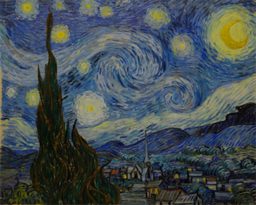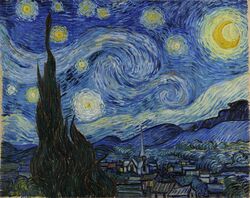Twinkling painting
| ||||||
 The twinkling painting in Animal Crossing: New Horizons | ||||||
| Real-world counterpart | ||||||
|---|---|---|---|---|---|---|
| The Starry Night | ||||||
| Year | 1889 | |||||
| Artist | Vincent van Gogh | |||||
| Main appearances | ||||||
|
| ||||||
Name in other languages
またたくめいが
闪烁的名画 Toile scintillante Paisaje estrellado Quadro sfavillante Звездная картина
반짝이는 명화 閃爍的名畫 Toile scintillante Paisaje estrellado Funkelgemälde Nachtelijk schilderij | ||||||
The twinkling painting is a painting in Animal Crossing: New Horizons introduced in the 1.2.0 April Free Update. It is based on Vincent van Gogh's The Starry Night; it is one of two van Gogh pieces to be appear in the Animal Crossing series, alongside the flowery painting.
Art details
In New Horizons
| Museum description | Van Gogh's signature piece, painted while he was hospitalized at an asylum. This view from his room includes memories and imaginations. In letters to friends, the artist called it a failure. |
|---|---|
| Buy price | |
| Sell price | |
| Obtain from | |
| Authenticity | This painting is always genuine. |
| Furniture size |
Real-world information
Painted in 1889, The Starry Night depicts a sky full of stars, just before the sunrise, and it remains one of van Gogh's most iconic works—and one of the most iconic pieces of art in western culture as a whole—for its distinctive, heavily post-impressionist imagery, even compared to van Gogh's other works. The meaning of the painting was never explicitly stated by the artist and as such has become a breeding ground for interpretations, ranging from artistic abstraction to a reflection of van Gogh's deteriorating mental state (with him having been institutionalized the previous year following a mental breakdown, before suffering a second one the month after the painting's completion; the painting specifically depicts the view from the window of his asylum cell, and van Gogh would commit suicide shortly after in 1890).
| Art | ||||||||||||||||||||||||
|---|---|---|---|---|---|---|---|---|---|---|---|---|---|---|---|---|---|---|---|---|---|---|---|---|
| ||||||||||||||||||||||||
